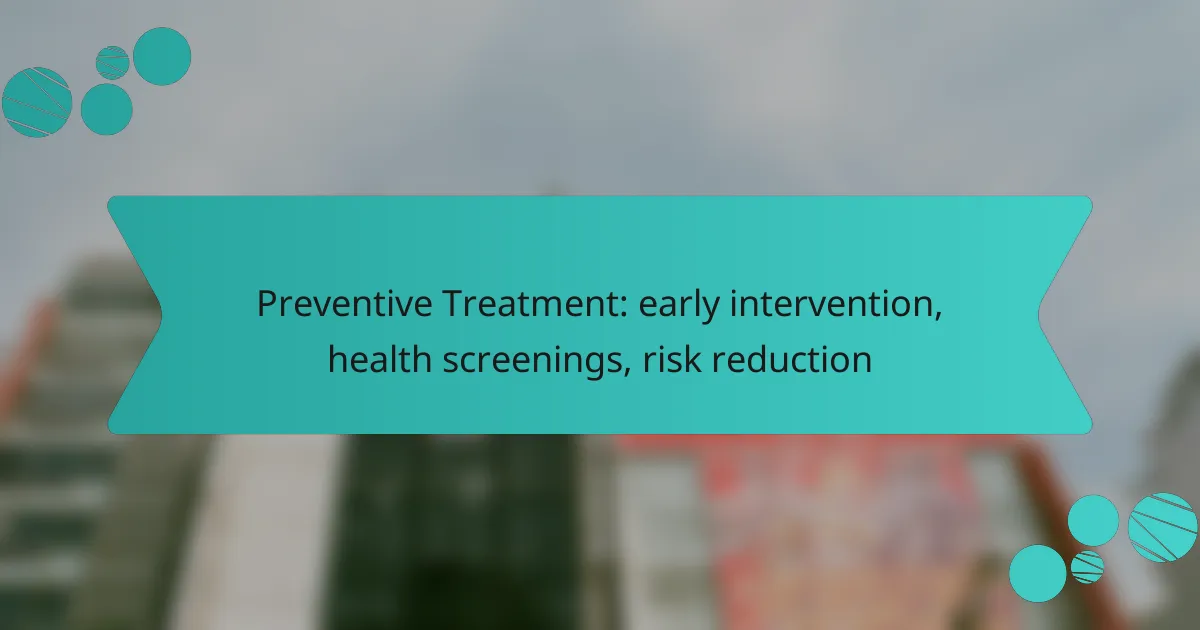Preventive treatment plays a crucial role in enhancing health outcomes by facilitating early disease detection and risk reduction. Through proactive health screenings and early interventions, individuals can identify potential health issues before they develop into serious conditions, leading to improved quality of life and significant cost savings in healthcare. Engaging in regular screenings empowers Canadians to take charge of their health and make informed decisions for a healthier future.

What are the benefits of preventive treatment in Canada?
Preventive treatment in Canada offers significant advantages, including early disease detection, cost savings on healthcare, and improved quality of life. These benefits stem from proactive health screenings and interventions that help manage risks before they escalate into serious health issues.
Early detection of diseases
Early detection of diseases through preventive treatment allows for timely interventions, which can significantly enhance treatment outcomes. Regular health screenings, such as mammograms and colonoscopies, can identify conditions like cancer at earlier, more treatable stages.
For example, Canadians aged 50 and older are often encouraged to undergo regular screening for colorectal cancer. This proactive approach can reduce mortality rates and lead to better long-term health outcomes.
Cost savings on healthcare
Preventive treatment can lead to substantial cost savings for both individuals and the healthcare system. By addressing health issues early, patients can avoid more expensive treatments and hospitalizations that arise from advanced diseases.
Studies suggest that for every dollar spent on preventive care, the healthcare system can save several dollars in future treatment costs. This is particularly relevant in Canada, where the public healthcare system aims to allocate resources efficiently.
Improved quality of life
Engaging in preventive treatment can significantly enhance an individual’s quality of life by promoting better health and reducing the burden of chronic diseases. Regular check-ups and screenings help individuals stay informed about their health status and make necessary lifestyle adjustments.
For instance, managing risk factors such as high blood pressure or diabetes through preventive measures can lead to a more active and fulfilling life. Canadians who prioritize preventive care often report higher levels of satisfaction with their health and well-being.

How can early intervention reduce health risks?
Early intervention can significantly lower health risks by identifying potential issues before they escalate. By proactively addressing these concerns through screenings and lifestyle modifications, individuals can improve their overall health outcomes and reduce the likelihood of serious diseases.
Identifying risk factors
Identifying risk factors is crucial for effective early intervention. Common risk factors include family history, lifestyle choices, and environmental influences. Regular health screenings can help detect these risks early, allowing for timely action.
For example, a family history of heart disease may prompt earlier cholesterol and blood pressure checks. Similarly, lifestyle factors such as smoking or obesity can be monitored through routine assessments, enabling individuals to make informed health decisions.
Implementing lifestyle changes
Implementing lifestyle changes is a vital step in reducing health risks identified through early intervention. Simple adjustments, such as adopting a balanced diet, increasing physical activity, and managing stress, can lead to significant health improvements.
For instance, incorporating at least 150 minutes of moderate exercise weekly can enhance cardiovascular health. Additionally, reducing processed foods and increasing fruit and vegetable intake can lower the risk of chronic diseases. It’s essential to set realistic goals and gradually integrate these changes into daily routines for lasting effects.

What health screenings are recommended for Canadians?
Canadians are encouraged to undergo various health screenings to identify potential health issues early. These screenings can help in the timely management of conditions, ultimately reducing health risks and improving outcomes.
Routine blood pressure checks
Routine blood pressure checks are essential for monitoring cardiovascular health. Adults should have their blood pressure measured at least once every two years, or more frequently if they have risk factors such as obesity or a family history of hypertension.
High blood pressure often has no symptoms, making regular checks crucial. If readings are consistently elevated, lifestyle changes or medication may be necessary to reduce the risk of heart disease and stroke.
Screening for diabetes
Screening for diabetes is vital, especially for individuals over 40 or those with risk factors like obesity or a sedentary lifestyle. The Canadian Diabetes Association recommends screening every three years for adults in these categories.
Testing typically involves a fasting blood glucose test or an A1C test, which measures average blood sugar levels over the past few months. Early detection can lead to effective management strategies, including diet, exercise, and medication.
Cancer screenings (e.g., mammograms)
Cancer screenings, such as mammograms for breast cancer, are recommended for women starting at age 50, with some guidelines suggesting earlier screening for those with higher risk factors. Regular screenings can detect cancer at an earlier, more treatable stage.
Other important cancer screenings include Pap tests for cervical cancer and colonoscopies for colorectal cancer, typically starting at age 50. These screenings can significantly reduce cancer mortality rates through early intervention.

What role do vaccinations play in preventive treatment?
Vaccinations are a crucial component of preventive treatment, designed to protect individuals from infectious diseases by stimulating the immune system. By receiving vaccines, people can significantly reduce their risk of contracting illnesses that can lead to severe health complications or even death.
Preventing infectious diseases
Vaccinations work by introducing a harmless component of a pathogen, such as a protein or a weakened form, prompting the immune system to recognize and fight the actual disease. This proactive approach helps prevent outbreaks of diseases like measles, polio, and influenza, which can spread rapidly in communities. Regular immunization schedules, often recommended by health authorities, ensure that individuals are protected throughout their lives.
For example, the Centers for Disease Control and Prevention (CDC) recommends that children receive vaccines for diseases like chickenpox and hepatitis B at specific ages. Adults should also keep up with vaccinations, such as the annual flu shot and tetanus boosters, to maintain immunity.
Reducing healthcare costs
Vaccinations can lead to significant cost savings for both individuals and healthcare systems by preventing diseases that require expensive treatments. By avoiding hospitalizations and long-term health complications, vaccinated individuals contribute to lower overall healthcare expenditures. For instance, the cost of a single vaccine is often much less than the expenses associated with treating a serious illness.
Moreover, widespread vaccination can reduce the economic burden on communities. When vaccination rates are high, herd immunity is achieved, protecting those who cannot be vaccinated due to medical reasons. This collective immunity helps prevent outbreaks, ultimately saving public health resources and taxpayer money.

How to choose the right preventive care services?
Choosing the right preventive care services involves assessing your health needs and understanding available options. Focus on services that align with your personal health risks and family history to maximize benefits.
Consulting healthcare professionals
Engaging with healthcare professionals is crucial for selecting appropriate preventive care services. They can provide personalized recommendations based on your health status, lifestyle, and risk factors.
Consider scheduling regular check-ups with your primary care physician, who can guide you on necessary screenings and vaccinations. Specialists may also offer insights tailored to specific health concerns, such as cardiology or oncology.
Evaluating personal health history
Your personal health history plays a significant role in determining which preventive care services are essential. Review your medical records and consider factors like chronic conditions, family illnesses, and lifestyle choices.
For example, if heart disease runs in your family, you may need more frequent cholesterol checks or cardiovascular screenings. Keeping a detailed health history can help you and your healthcare provider make informed decisions about necessary preventive measures.

What are the costs associated with preventive treatments?
The costs associated with preventive treatments can vary widely based on factors such as insurance coverage, the type of screening or intervention, and individual health needs. Understanding these costs is essential for effective health management and budgeting.
Insurance coverage options
Many health insurance plans cover preventive treatments at little to no cost to the patient, as mandated by regulations in various countries. This typically includes routine screenings, vaccinations, and annual check-ups. However, the extent of coverage can differ significantly between plans, so it’s crucial to review your specific policy.
For example, in the United States, the Affordable Care Act requires most insurance plans to cover preventive services without charging a copayment or deductible. Check with your insurer to confirm which services are fully covered and if any conditions apply.
Out-of-pocket expenses
Out-of-pocket expenses for preventive treatments can include costs for services not covered by insurance, such as certain specialized screenings or tests. These costs can range from modest fees for basic screenings to higher amounts for advanced diagnostic procedures.
To manage out-of-pocket expenses, consider setting aside funds in a health savings account (HSA) or flexible spending account (FSA) if available. Additionally, inquire about payment plans or discounts for upfront payments at healthcare facilities to reduce overall costs.

How do lifestyle changes impact preventive health?
Lifestyle changes significantly enhance preventive health by reducing the risk of chronic diseases and improving overall well-being. By adopting healthier habits, individuals can lower their chances of developing conditions such as heart disease, diabetes, and certain cancers.
Dietary modifications
Dietary modifications play a crucial role in preventive health by influencing body weight, cholesterol levels, and blood pressure. A balanced diet rich in fruits, vegetables, whole grains, and lean proteins can help mitigate health risks and promote longevity.
Consider incorporating a variety of nutrient-dense foods while limiting processed items high in sugars and unhealthy fats. Aim for a daily intake of at least five servings of fruits and vegetables, and choose whole grains over refined options to enhance fiber intake.
Be mindful of portion sizes and consider using smaller plates to help control calorie intake. Planning meals ahead of time and keeping healthy snacks on hand can prevent impulsive eating choices that may lead to weight gain and associated health issues.
